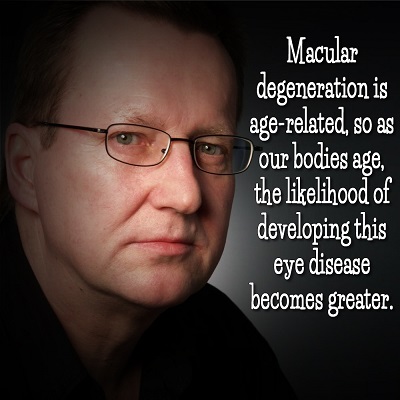 Eye diseases are scary, to say the least. We only have two eyes and they are supposed to last us for an entire lifetime. Not to mention, they are incredibly small for the job they have been assigned: sight!
Eye diseases are scary, to say the least. We only have two eyes and they are supposed to last us for an entire lifetime. Not to mention, they are incredibly small for the job they have been assigned: sight!
Macular degeneration is age-related, so as our bodies age, the likelihood of developing this eye disease becomes greater. The good news is it typically doesn’t affect those people under 50. The bad news is, if you’ve been diagnosed with macular degeneration, there is no known “cure” for it.
The Spectacular Macula
The eyeball has many parts, and each part performs a unique and incredibly important job. You can thank your macula, measuring a whopping 5mm across, for bringing you virtually ALL of your central vision, the majority of your color vision and the fine details of what you’re seeing.
The remaining portion of the retina is what gives us peripheral vision. We depend on what’s in front of us a great deal more than what’s on the side of us, so the importance of a properly functioning macula is tremendous.
The macula is but a small part of the retina but has a super high concentration of photoreceptor cells. These cells are what detect light that’s let in the inner eye and then sends the signal to the brain via the optic nerve. This is how we get from light rays entering the eye to actual recognizable images.
Macular Degeneration Simplified
Key Points:
- This is an age-related disease affecting mostly folks over 50. At age 60, about 1 in 200 people are diagnosed with macular degeneration. At age 90, about 1 in 5 are diagnosed.
- It is caused by natural deterioration of the macula.
- Macular degeneration affects mainly the central visual field.
- As present, there is no cure.
- In the early stages, vision is not affected.
- As the disease progresses, there is distorted and blurred vision.
- The last stage is blindness, though there will never be complete blindness with macular degeneration as it does not affect the peripheral field of vision.
Two Types of Macular Degeneration
There are two types of macular degeneration: Dry and Wet. The majority of diagnosed cases are dry with only about 10-20% being wet. With dry macular degeneration, parts of the macula get thinner and protein deposits grow. The progression is slow and central vision is eventually lost.
Wet macular degeneration is much less common but the worse of the two types. The progression is faster therefore, vision is lost at a much quicker rate. It happens when new blood vessels are formed in the retina, but they are abnormal and leak blood or other fluids which end up scarring the macula.
The Signs and Symptoms
It can affect people differently. The best way to describe it is to look at a photograph. In those with normal vision, every detail of the photo can be seen. The colors, lines, shading and shapes are all there. You can see exactly what’s in the photo.
Now, take a dark grey or black marker and draw a cloud smack dab in the middle of the photo. Make the edges of the cloud billowy, rounded and lighter than the center. With the dark cloud in the middle of the photo, now you are unable to see a great deal about it.
Straight lines could look bent or slightly distorted if they are interrupted by the cloud. Words in a book disappear. Driving becomes too dangerous to attempt.
At first the cloud might be translucent but still present, like when there’s a smudge on your sunglasses. It’s annoying, but you can still see through it if you concentrate. As time passes, the smudge gets darker and darker and loses its translucency.
Diagnosis and Treatment
For both dry and wet macular degeneration, the diagnostic stools are pretty much the same. Your eye care professional can detect problems with your macula with a comprehensive eye exam. If they notice an issue, further studies might be indicated, like an OCT (ocular coherence tomography) scan.
If your optometrist believes you may have wet type macular degeneration, a referral is usually made to a retinal specialist and shouldn’t be more than a week or so in the future. Early detection and treatment of wet type is critical.
There are major studies under way, but unfortunately, macular degeneration is incurable at the present time. The treatments options are meant to slow the progression of the disease or prevent severe vision loss. Steroid injections, laser surgery and low-vision aids are the among the available options at the current time.
Aging is a fact of life, and just because our bodies get older does not mean we will definitely be diagnosed with macular degeneration. Recent research is even pointing toward vitamin and mineral supplements to aid in macular degeneration prevention.
No matter what, make sure to keep up with your annual eye examinations and report any abnormal visual disturbances immediately.






